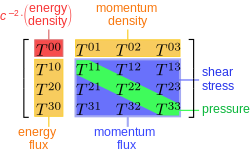I just wanted to say that to prevent cancellation of this blog and account I am showing that I am alive and well.
Tuesday, August 08, 2023
Tuesday, May 10, 2022
Black hole Annoucements on May 12th
Sunday, August 22, 2021
Monday, December 14, 2020
Saturday, December 05, 2020
Perfect Fluid
Perfect fluid
In physics, a perfect fluid is a fluid that can be completely characterized by its rest frame mass density 
Real fluids are "sticky" and contain (and conduct) heat. Perfect fluids are idealized models in which these possibilities are neglected. Specifically, perfect fluids have no shear stresses, viscosity, or heat conduction.
In space-positive metric signature tensor notation, the stress–energy tensor of a perfect fluid can be written in the form
where U is the 4-velocity vector field of the fluid and where 
In time-positive metric signature tensor notation, the stress–energy tensor of a perfect fluid can be written in the form
where U is the 4-velocity of the fluid and where 
This takes on a particularly simple form in the rest frame
where 

Perfect fluids admit a Lagrangian formulation, which allows the techniques used in field theory, in particular, quantization,
to be applied to fluids. This formulation can be generalized, but
unfortunately, heat conduction and anisotropic stresses cannot be
treated in these generalized formulations.[why?]
Perfect fluids are used in general relativity to model idealized distributions of matter, such as the interior of a star or an isotropic universe. In the latter case, the equation of state of the perfect fluid may be used in Friedmann–Lemaître–Robertson–Walker equations to describe the evolution of the universe.
In general relativity, the expression for the stress–energy tensor of a perfect fluid is written as
where U is the 4-velocity vector field of the fluid and where 
See also
References
- The Large Scale Structure of Space-Time, by S.W.Hawking and G.F.R.Ellis, Cambridge University Press, 1973. ISBN 0-521-20016-4, ISBN 0-521-09906-4 (pbk.)
External links
- Mark D. Roberts, [A Fluid Generalization of Membranes http://www.arXiv.org/abs/hep-th/0406164 hep-th/0406164].
Tuesday, December 01, 2020
Past String Conferences
Strings 2019, Brussels, Belgium
Strings 2018, Okinawa, Japan
Strings 2017, Israel
Strings 2016, Beijing, China
Strings 2015, Bengaluru, India
Strings 2014, Princeton, USA
Strings 2013, Seoul, Korea
Strings 2012, Munich, Germany
Strings 2011 Uppsala, Sweden
Strings 2010 Texas, USA
Strings 2009, Rome, Italy
Strings 2008, CERN, Switzerland
Strings 2007, Madrid, Spain
Strings 2006, Beijing, China
Strings 2005, Toronto, Canada
Strings 2004, Paris, France
Strings 2003, Kyoto, Japan
Strings 2002, Cambridge, United Kingdom
Strings 2001, Mumbai, India
Strings 2000, Ann Arbor, USA
Strings 1999, Potsdam, Germany
Strings 1998, Santa Barbara, USA
Strings 1997, Amsterdam, The Netherlands
Strings 1996, Santa Barbara, USA
Strings 1995, Los Angeles, USA
Monday, November 23, 2020
Solar Panel Revolution in the Wind?

I am encouraged by some research that is currently going on that is improving the efficiency of solar panels up and coming. This encouragement is based on designs I have seen in corollary manufacturing processes that could created a whole new industry.
It is a whole new research path that could greatly improve the energy retention otherwise seemingly at a standstill, although these manufacturing processes for solar panels are currently inexpensive.
I have been pondering these ideas for sometime now and since the move to electrics for transportation is now more important then ever as I open the door to the studious and bright innovators who wonder about these potentials.
New solar panel design could increase efficiency by 125%
Dr. Christian Schuster, researcher from the Department of Physics, told The Week news “We found a simple trick for boosting the absorption of slim solar cells. Our investigations show that our idea actually rivals the absorption enhancement of more sophisticated designs, while also absorbing more light deep in the plane and less light near the surface structure itself. Our design rule meets all relevant aspects of light trapping for solar cells, clearing the way for simple, practical, and yet outstanding diffractive structures, with a potential impact beyond photonic applications.” He added, “This design offers potential to further integrate solar cells into thinner, flexible materials and therefore create more opportunity to use solar power in more products.”
See also: Frogs, Foam and Fuel: UC Researchers Convert Solar Energy to Sugars
Thursday, August 20, 2020
Everyday Einstein: GPS & Relativity
See also: Everyday Einstein: GPS and Relativity @Perimeter Institute for Theoretical Physics






![\left[{\begin{matrix}\rho _{e}&0&0&0\\0&p&0&0\\0&0&p&0\\0&0&0&p\end{matrix}}\right]](https://wikimedia.org/api/rest_v1/media/math/render/svg/875c5a58c98b9d041855127d579206c801800fe0)

